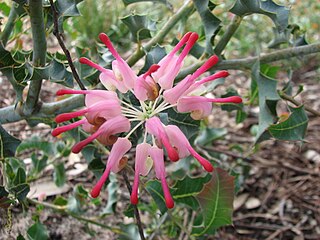
Grevillea tetragonoloba is an erect or spreading shrub which is endemic to Western Australia. The red or brown "toothbrush" flowers appear between early winter and late spring. The species occurs in an area between Albany and Esperance on sandy or loam soils. It grows to between 0.6 and 2.6 m high.

Grevillea obtusifolia, the obtuse-leaved grevillea, is a shrub which is endemic to the south-west of Western Australia. It grows up to between 0.5 and 1.5 metres in height and up to 5 metres in width. It produces pink to red flowers between August and November in its native range.

Grevillea pilosa is a low growing shrub which is endemic to the south-west of Western Australia. It grows to between 0.4 and 1 metre in height and produce red or pink flowers between June and December in its native range.

Grevillea endlicheriana, commonly known as spindly grevillea, is a species of flowering plant in the family Proteaceae and is endemic to the south-west of Western Australia. It is an erect shrub with linear leaves, and groups of white, pink tinged flowers.

Grevillea ripicola, commonly known as Collie grevillea, is a shrub which is endemic to the south west region of Western Australia. It grows to between 0.6 and 2 metres in height and up to 4 metres in width. The species was first formally described by botanist Alex George in Nuytsia in 1974 based on plant material collected at Collie. It is classified as Priority Four Flora (Rare) under the Wildlife Conservation Act in Western Australia.

Grevillea drummondii, commonly known as Drummond's grevillea, is a species of flowering plant in the family Proteaceae and is endemic to the south-west of Western Australia. It is a low, spreading to erect shrub with narrowly elliptic to narrowly egg-shaped leaves with the narrower end towards the base, and dense groups of cream-coloured flowers that turn pink or red as they age.

Grevillea pimeleoides is a shrub which is endemic to the south west region of Western Australia.

Grevillea pinaster is a shrub in the family Proteaceae. It is endemic to south-western Western Australia.

Grevillea hookeriana, commonly known as red toothbrushes or Hooker's grevillea, is a species of flowering plant in the family Proteaceae and is endemic to the south-west of Western Australia. It is a spreading to erect shrub, usually with linear leaves or deeply divided leaves with linear lobes, and toothbrush-shaped groups of red, black or yellowish green flowers, the style maroon to black.

Grevillea sarissa, the wheel grevillea, is a shrub which is native to South Australia and Western Australia.

Grevillea pectinata, commonly known as comb-leaf grevillea, is a shrub in the family Proteaceae. It is endemic to the south-west of Western Australia.

Grevillea diversifolia, the variable-leaved grevillea, is a species of flowering plant in the family Proteaceae and is endemic to the south-west of Western Australia. It is an erect to prostrate shrub with simple or divided leaves and groups white to cream-coloured flowers with a dull red style.

Grevillea biternata is a species of flowering plant in the family Proteaceae and is endemic to the south-west of Western Australia. It is a shrub with divided leaves with linear lobes and clusters of white flowers.

Grevillea insignis, commonly known as wax grevillea, is a species of flowering plant in the family Proteaceae and is endemic to the south-west of Western Australia. It is an erect, bushy shrub with more or less oblong leaves with seven to seventeen sharply-pointed, triangular teeth, and more or less spherical or cylindrical clusters of cream-coloured flowers ageing to pink.

Grevillea newbeyi is a shrub which is endemic to the south west region of Western Australia. It grows to between 0.5 and 1.5 metres in height. The pink to red and cream flowers usually appear from June to December in the species' native range. The species was first formally described by Donald McGillivray in 1986, his description published in New Names in Grevillea (Proteaceae).
Grevillea nematophylla, commonly known as water bush or silver-leaved water bush, is a species of flowering plant in the family Proteaceae and is endemic to Australia. It is shrub or small tree with simple or pinnatisect leaves, the leaves or lobes linear, and branched, cylindrical clusters of cream-coloured flowers.

Grevillea brachystylis, also known as short-styled grevillea, is a species of flowering plant in the family Proteaceae and is endemic to the south-west of Western Australia. It is a low, spreading to erect shrub with linear to narrow egg-shaped leaves with the narrow end towards the base, and wheel-like clusters of hairy red flowers.

Grevillea candolleana, commonly known as the Toodyay grevillea, is a species of flowering plant in the family Proteaceae and is endemic to a restricted part of the south-west of Western Australia. It is a shrub with narrow egg-shaped to linear leaves and white to cream-coloured flowers.

Grevillea manglesioides is a species of flowering plant in the family Proteaceae and is endemic to the south-west of Western Australia. It is a spreading shrub usually with wedge-shaped leaves with lobed ends, and toothbrush-shaped clusters of flowers, the colour varying with subspecies.

Pterochaeta is a monotypic plant genus in the Asteraceae family, endemic to Western Australia. It was first described in 1845 by Joachim Steetz and its only species is Pterochaeta paniculata.



















